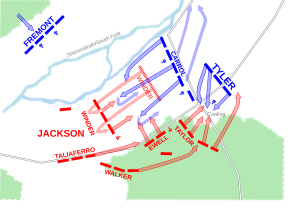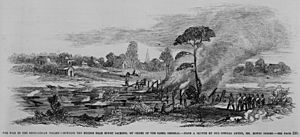Battle of Port Republic facts for kids
Quick facts for kids Battle of Port Republic |
|||||||
|---|---|---|---|---|---|---|---|
| Part of the American Civil War | |||||||
|
|||||||
| Belligerents | |||||||
| Commanders and leaders | |||||||
| Erastus B. Tyler | Stonewall Jackson | ||||||
| Strength | |||||||
| 3,500 | 6,000 | ||||||
| Casualties and losses | |||||||
| 1,002 | 816 | ||||||
The Battle of Port Republic happened on June 9, 1862, in Rockingham County, Virginia. It was part of Confederate General Stonewall Jackson's special plan, called the Valley Campaign, during the American Civil War. This battle was a tough fight between two strong armies. It was the most difficult battle for Jackson's army during his campaign.
The battles of Cross Keys (fought the day before) and Port Republic were big wins for the Confederates. These victories made the Union armies leave the area. This allowed General Jackson to join General Robert E. Lee for the Seven Days Battles near Richmond, Virginia.
Contents
What Led to the Battle?
On the night of June 8, 1862, Confederate General Charles Sidney Winder's troops, known as the Stonewall Brigade, moved back to join Jackson's main group at Port Republic. Confederate soldiers quickly built a bridge using wagons across the South Fork of the Shenandoah River at Port Republic.
General Winder's brigade was chosen to lead the attack against Union forces on the east side of the river. Other Confederate troops stayed behind to slow down Union General John C. Frémont's forces at Cross Keys. The rest of General Richard S. Ewell's division marched to Port Republic to help Winder's attack.
Meanwhile, Union General Erastus B. Tyler's brigade joined Colonel Samuel S. Carroll's brigade north of Lewiston. The rest of General James Shields's division was spread out on muddy roads back to Luray. General Tyler, who was in charge on the field, moved forward at dawn on June 9. He set up his army with cannons on a hill called the Lewiston Coaling. His soldiers stretched west along Lewiston Lane to the South Fork. He had 16 cannons supporting his troops.
Who Fought in the Battle?
Union Forces
Confederate Forces
The Battle Begins
Winder's Confederate brigade crossed the river by 5 a.m. and got ready to attack across the open field. Winder sent two regiments, the 2nd Virginia and 4th Virginia, into the woods. Their job was to go around the Union line and attack the Coaling hill.
When the main Confederate line moved forward, Union cannons fired heavily at them. The Confederates were quickly stopped. Confederate cannons were brought closer but were outmatched and had to move to safer spots. General Ewell's brigades quickly crossed the river to help.
General Jackson saw how strong the Union cannons were at the Coaling. He sent Richard Taylor's brigade, which included the famous Louisiana Tigers, into the woods. They went to the right to help the other troops trying to get through the thick bushes.
Winder's brigade attacked the Union right and center again, but they lost many soldiers. General Tyler moved two regiments from the Coaling to his right and launched a counterattack. They pushed the Confederate forces back almost half a mile. At the same time, the first Confederate regiments tried to attack the Coaling but were pushed back.
Jackson realized the fight was harder than he thought. He ordered the rest of Ewell's troops to cross the rivers and burn the North Fork bridge. These new soldiers helped Winder's line, stopping the Union counterattack.
Taylor's brigade reached a spot in the woods across from the Coaling. They launched a strong attack and captured the hill, taking five cannons. Tyler immediately fought back with his reserve troops. In hand-to-hand fighting, they took the hill back. Taylor moved a regiment to the far right to go around the Union line. The Confederate attack pushed forward again and captured the Coaling. Five captured cannons were then used against the rest of the Union line.
With the Coaling lost, the Union position became too weak to hold. Tyler ordered his troops to retreat around 10:30 a.m. Jackson then ordered a full advance.
William B. Taliaferro's fresh Confederate brigade arrived and chased the retreating Union soldiers for several miles. They captured hundreds of prisoners. The Confederate army had won the battle.
Soon after noon, Frémont's Union army started to arrive on the west bank of the South Fork. They were too late to help Tyler's defeated troops. They watched helplessly from across the river, which was swollen from rain. Frémont placed cannons on the high cliffs to fire at the Confederate forces. Jackson slowly moved his army back into the woods and gathered them near Mt. Vernon Furnace. Jackson thought Frémont would cross the river and attack the next day. But during the night, Frémont's army left and moved toward Harrisonburg.
What Happened After the Battle?
After losing at Cross Keys and Port Republic, the Union armies retreated. This left Jackson in control of the Shenandoah Valley. It also meant his army was free to join Robert E. Lee near Richmond, Virginia for the Seven Days Battles.
Protecting the Battlefield
The American Battlefield Trust and its partners have worked to save 947 acres (about 3.8 square kilometers) of the Port Republic battlefield since 1988. The battlefield is located about three miles east of Port Republic. It still looks much like it did during the war, with farms and fields.
The Port Republic Battle Monument is on Ore Bank Road, next to the Coaling hill. The Coaling was the first piece of land saved by the modern effort to protect Civil War battlefields. This 8.55-acre site was given to the Trust's first group, the Association for the Preservation of Civil War Sites, in 1988.




